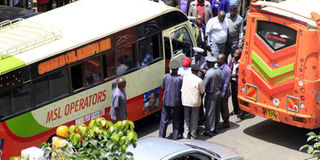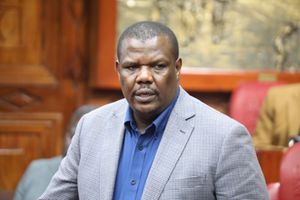It’s time to drop meaningless formal-informal economic model

People and matatus along Moi Avenue in Nairobi on April 12, 2016. PHOTO | DIANA NGILA | NATION MEDIA GROUP
What you need to know:
- Informal public transport system employs as many people directly as government and the formal private sector combined.
- The matatu industry is a very competitive and dynamic industry that continues to defy corporatisation.
A story is told how one Dedan Nduati Njoroge, better known as Jogoo Kimakia, led a delegation of country bus owners to Jomo Kenyatta to complain about matatus. This was back in the day when the mighty OTC and “country bus” fleets such as Mawingo and Jogoo Kimakia ruled the roost on the long distance routes, and the trip from Nairobi to Nyeri took the better part of the day. The matatu was either a dangerously decrepit Ford van plying Nairobi’s back routes or the rural converted pick-up where passengers sat eyeball-to-eyeball, and the sneeze of a tobacco-sniffing elder sitting on the opposite side was a clear and present danger.
Mzee Kenyatta, the stories go, engaged Jogoo to establish that matatus were, indeed, a serious threat to their business, which he enthusiastically confirmed. Then Jomo delivered the sucker punch: “Gentlemen, if I were you, I’d sell buses and buy matatus.”
Jomo Kenyatta legitimised the matatu industry in 1973, in response to lobbies by the matatu owners. He decreed that they could legally conduct their business without specific regulation other than complying with insurance and traffic regulations. The bus owners’ delegation, if it happened at all, could have been a response to this decree.
The industry never looked back. Researchers estimated that there were 40,000 matatus in Kenya by 2003, employing 300,000 people, up from 18,000 in 1990. Extrapolating this suggests that there are upwards of 100,000 matatus today, employing close to a million people. Matatus have recently been joined by boda bodas, of which there are, by my estimate, over 800,000 employing more than a million people. This suggests that the informal public transport industry employs as many people directly as the government and the formal private sector combined.
Our informal sector policy discourse is characterised by a generic stereotype. What comes to the mind of most people is mama mboga, the “jua kali” garage, and the national army of artisans that churn out the same karais and jikos year in year out. The underlying presumption that informal is an inferior form of business organisation. The goal of policy is to formalise it. It is an article of faith that informal entrepreneurs are deprived, in much need of capital and capacity building.
QUINTESSENTIAL ONE
The matatu industry is the quintessential informal industry. It challenges this stereotype. It is a very competitive and dynamic industry that continues to defy corporatisation. There have been many attempts to corporatise it. In the 1970s, companies such as the Rift Valley Peugeot emerged, then disappeared.
“Michuki Rules” also sought to give an edge to corporatised transport companies such as “City Hoppa”, but these also proved to be a flash in the pan.
One of the government’s persistent efforts in recent times has been an attempt to phase out the 14-seater vans in favour of higher capacity vehicles. The runaway success of the boda bodas suggests that the government is paddling upstream. The market says it wants more flexible public transport, on demand. Even if we could argue that a corporatised industry, whether public or private, would be preferable to the chaotic matatu industry, it is hard to see how the boda boda service could be corporatised.
Why did matatus drive out buses? Why does the industry continue to defy corporatisation? It turns out that it is more useful to ask the opposite question? Why did Jogoo Kimakia end up owning a fleet of over 100 buses in the first place?
Ronald Coase was an American economist better known for his “theory of the social cost”, a seminal contribution to the field of law and economics for which he was awarded the 1991 economics Nobel Prize. In a celebrated 1937 paper, ‘The Nature of the Firm’, Coase asked what at first appears to be a silly question: Why do firms exist? “Our task” he wrote “is to discover why a firm emerges at all in a specialised exchange economy.”
To see where Coase is coming from, we need to go back to Adam Smith’s thesis that the free market makes societies prosperous because it enables specialisation and division of labour. By specialising, every person becomes more productive. A cobbler develops the skill to make five pairs of shoes in a day, but if I were to make my own shoes every so often, it would probably take me two days to make a bad pair.
'COST MORE'
“It is the maxim of every prudent master of a family, never to attempt to make at home what it will cost him more to make than to buy... What is prudence in the conduct of every private family, can scarce be folly in that of a great kingdom…It is the great multiplication of the productions of all the different arts, in consequence of the division of labour, which occasions, in a well-governed society, that universal opulence which extends itself to the lowest ranks of the people.”
The free market that Adam Smith characterised is what Coase is referring to as “specialised exchange economy”. It can be observed in our jua kali garages where one finds many independent specialists, mechanical and electrical technicians, panel beaters, welders, upholsterers etc., all working together but none employing the other. Coase’s question can then be posed as follows: Why does the entire economy not operate like our jua kali garages? Why do we observe garage enterprises that employ their mechanics for a fixed wage, whether they work or not, instead of contracting their services as and when needed?
His answer was transactions costs. Transactions costs are what we might call procurement costs such as search costs (for example, advertising for a service and evaluating different offers), legal costs of contracting and contract enforcement etc. But internalisation also has its costs. As the entrepreneur takes on more non-core functions, there are also costs such as higher overhead and organisational complexity. Coase theorised that entrepreneurs will hire a person when the transactions of procuring the service are higher than the internal costs of maintaining the employee.
Historically, technology has facilitated internalisation of functions, in other words, the growth of big firms. Consider computing. In the age of mainframe computing, only big firms could leverage on computing. But from global outsourcing to Uber and AirBnB, the digital age is evidently fundamentally transforming the relationship between technology and industrial organisation. One of the ways it is doing this is by “decorporatising” the economy.
Safaricom is Kenya’s biggest enterprise, with 24 million customers, 15 million of them M-Pesa users. It has just over 4,000 employees. But we, of course, know that this is a fraction of Safaricom’s actual workforce, as the customer service function is provided by over 100,000 independent agents. Since adopting the agency model three years ago, commercial banks have hired thousands of agents.
INFORMAL EATERIES
The once prestigious office job now resides in barbershops and informal eateries. It begs the question: Is the agency mobile banking model contributing to informalisation of the formal informal, or formalisation of the informal? Which brings me to the subject of my last column, namely taxation of jua kali. Tax revenue has doubled over the last five years, from Sh518 billion in 2009/10 to Sh1.03 trillion in 2014/15. Income tax revenue has grown much faster than the other taxes, by 130 percent compared to 80 per cent for the others. At Sh500 billion, income tax revenue in 2014/15 was close to the total tax receipts five years ago.
The mobile and banking industries are a significant part of this revenue story. Safaricom alone paid Sh21 billion income tax in 2015, four per cent of the total. The bottom of the pyramid financial revolution has catapulted Equity Bank into the country’s most profitable bank. It paid Sh7 billion income tax in 2015. This trend seems to suggest that this formal-informal linkage is revenue positive, and the government’s preoccupation with bringing the informal economy into the tax net is largely misplaced.
Back in the day, in the era of import substitution, the government cottoned on the idea of assembling motor vehicles domestically, and supported the establishment of three assembly plants. The idea was that progressively, the industry would integrate backwards with more and more components made locally, culminating in manufacturing the entire car domestically. Things did not go according to plan, and the industry became the proverbial infant industry that never grow up. It is still crawling.
I have read in the press of at least four motorcycle assembly plants that have been set up in recent times. Last year, the industry launched an association, the Motorcycle Assemblers Association of Kenya. The industry said its goal was to increase local value added to 35 per cent of the motor-cycles sold in Kenya. The motor manufacturing industry may yet come to be—driven by jua kali.
It seems to me that it is about time we abandoned this formal-informal dichotomy. As Deng Xiaoping said, it matters not whether a cat is black or white, as long as it catches mice.





